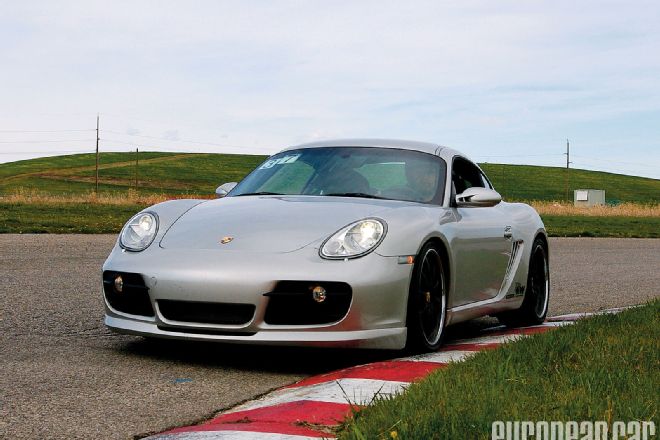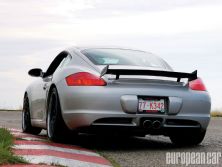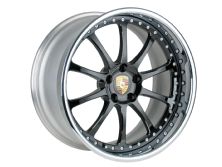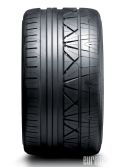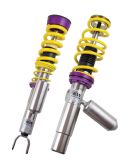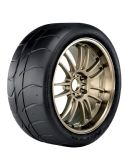All was quiet in the 14 bay workshop at Norden Autohaus. With every engine part securely bolted into its new forbidden home, it was finally time to turn the key. The factory-fresh X51 engine cranked and reluctantly sputtered to life, much to our excitement. Project Cayman X51 had been nicely taking shape prior to its "mid-build" showing at the Edmonton International Autoshow, but this was the first real moment to be savored for all involved with this project car series.
Still, more work had to be completed to ready our road warrior for battle at the track and a few additional chassis upgrades were implemented. The OEM PASM suspension was completely removed in favor of KW Suspensions Variant 3 coilovers, selected for their increased spring rates and full adjustability of ride-height, bump and rebound. Tarrett Engineering anti-roll bars, links, tie rods, and rear toe control arms were added to the mix. This combination of parts would allow for a customized, fully adjustable setup for our Cayman; more on this later. New wheel and tire sets were also ordered for both the street and track. For street, we chose Forgeline ZX3-P wheels, 9x19 and 10x19, with quiet, surefooted, Nitto Invo tires in sizes 245/40 and 285/30, and for the track lightweight Forgeline ZX3-R wheels, 9x18 and 10x18, with sticky Nitto NT01 R-compounds, 245/40 and 275/35.
After a 200-mile shakedown run, everything seemed to be in order from a mechanical standpoint. REVO Technik spent considerable time making this engine swap "plug and play" from a communications integration and performance tuning perspective. Due to the mixing and matching of Cayman and 997S parts described in part two , it was necessary to significantly reprogram the Cayman ECU and additional control units to let them communicate precisely. Basic functions, check-engine lights, and diagnostic trouble codes needed to work as they do on a factory vehicle. The second challenge was engine tuning, and this began with the base X51 program. Adjustments were made to account for changes in various input mechanisms. For example, load tables had to be modified to work with the lighter 987 chassis, and scaling for the MAF calibration needed to be adapted to compensate for the improved intake and exhaust flow. Once the new base software was complete, fine-tuning could commence. Fuel and timing tables were adjusted to optimize performance and drivability under real-world street and track conditions in an iterative manner over a six-week period. The final software was uploaded via the diagnostic port without any need to physically access the ECU, and is now available through REVO dealers.
Now the real fun could finally begin, as it was time to dial in the chassis from scratch. Initial settings for alignment, anti-roll bars, shocks and tire pressures were estimated by distilling many conversations with Porsche techs, racers and enthusiasts. This could have become a nasty can of worms, but luckily the first attempt was quite an acceptable place to work from. This is because the vehicle would also be a daily driver, so some settings, such as toe and caster, remained stock. Also, ride height was only dropped 20mm to maximize suspension travel, and to allow reasonable ground clearance on the street. Camber was set to a modest -1.75 degrees in front, and -2.0 out back, the anti-roll bars were set to their middle settings, and the KW V3 shocks were set to the KW factory recommended settings for the Cayman S (bump F/R: 1.25/0.75 turns open and rebound F/R: 1.5/1.5 turns open). Being able to fully control the compression and rebound individually is quite an advantage for dialing in your desired handling characteristics (don't be fooled by other manufacturers that use one adjuster for both; this simply moves your whole range up or down).
Out of the box, Cayman X51 tended to dive a little too much under heavy braking, so compression up front and rebound out back were both stiffened, at the same time preserving the neutral handing. The car also tended to lean significantly in heavy cornering, so the anti-roll bars also needed to be stiffened up. The desired handling was finally complete after a combined iterative process which involved small incremental adjustments to each axle for both shocks and bars separately. This trial and error game can be interesting and fun, but it takes time and patience. It's a great learning experience that every enthusiast should try at least once, a taste of real motorsport testing on your own ride.
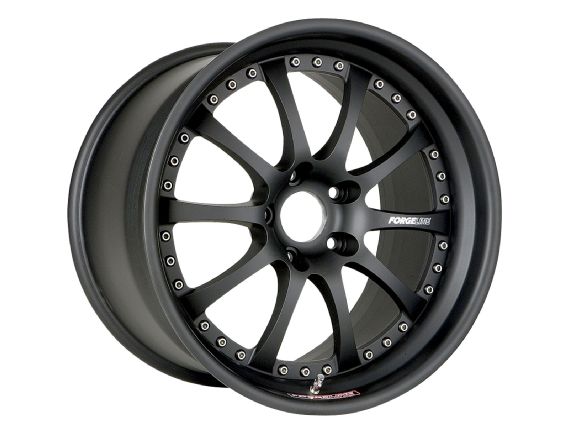 |
Forgeline ZX3-R
|
Forgeline ZX3-R
At the track, strapping into Cayman X51 takes extra time due to the Scroth six-point harness cinching you firmly into the GT3 Euro bucket seat. Your palms are already moist by the time you finally twist the ignition due to your anticipation of the upcoming thrills. The tuned 3.8-liter 997S X51 engine springs to life with aplomb, and settles to a satisfying steady rearward rumble from the custom headers and Supersprint metallic cats and mufflers. Selecting first gear with the slick B&M short shift kit is the next indication that this Cayman is now something very special. Easing out the heavy X51 spec Sachs clutch takes a little extra care and muscle, but smoothly gets you underway to warm things up. The ride is firm and the feedback through the steering wheel is greatly sharpened, due to the suspension modifications described above and the weld-in Cantrell half roll cage that increases structural rigidity. Once the engine, brake, and tire temperatures were up, it was time to probe the full capabilities of our "science project". With full throttle from 2000 rpm in second gear, the new power plant did not disappoint. Power is raw, linear, and amplified by the guttural exhaust note of the custom tuned flat six, as one pushes to the 7200 rpm redline in each gear. The shifts are quick, precise, and effortless as the speed increases feverishly; an exceedingly noticeable improvement over the factory Cayman S. Through the twisties, both slow and fast, the mid-engine chassis feels flat, fearless, and ready to react to any input you desire, while the Nitto NT01 R-compound tires provide enormous grip and feedback. Ladies and gentlemen, I believe we have a contender!
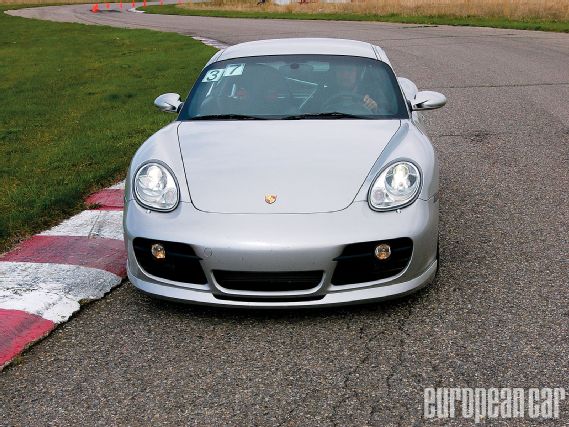 |
Porsche Cayman X51 - The Set Up*
|
Porsche Cayman X51 - The Set Up*
Next we test our wild creation in a head-to-head track shootout with the Cayman's bigger brother, the Porsche 911. Note: Since we seriously jumped the gun on its publication, for the shootout results, see The Test, european car, November 2009.
 |
Porsche Cayman X51 - The Set Up*
|
Porsche Cayman X51 - The Set Up*
Editor's Note: Apologies are in order here. We got so excited about Doug's three-way track shootout with Cayman X51, Project Z4 M and the mildly modded Carrera S that we bulled ahead and unintentionally published it before part three, this installment, where we really get into the overall chassis setup that would make it so competitive at the track. So here is part three in its entirety-revisited for the first time.

